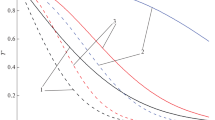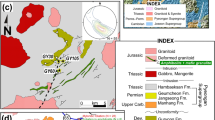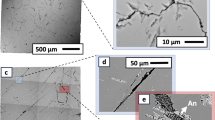Abstract
The effect of the composition of the sources and the thermal and baric evolution of metasomatic solutions on the character of metasomatic products was studied by numerically simulating solution-rock interaction. The rock sources of the solutions assumed in these simulations were shale, granite, and granodiorite. The relative acidity of the rocks and solutions interacting with them was suggested to estimate using the parameter \(A_R = \log \left( {a_{R^ + } /a_{H^ + } } \right) + \frac{1} {2}\log a_{H_2^O } \) (where R = K, Na). The values of this parameter in rocks differently vary with temperature and pressure and are controlled by buffer equilibria of minerals composing these rocks. The acidity of the solution relative to the source increases at cooling because of the more rapid dissociation of acids than salts and bases. However, the solution can be either more acidic or more alkaline relative to protoliths of other composition. Solutions derived from various sources but cooling in similar regime produce metasomatites of different composition. As the solution cools, feldspar metasomatites can grade into quartz-muscovite ones, which corresponds to the vertical temperature zoning of metasomatic aureoles. The alkalinity of solutions relative to their sources increases at their decompression, but the solutions may be less alkaline relative to protoliths of other composition. In contrast to cooling regime, solutions derived from all of the examined types of sources at decompression produce one of the feldspars and Ca, Mg, and Fe minerals, such as biotite, chlorite, amphibole, and magnetite. Quartz-free varieties of feldspathic metasomatites can be produced at either cooling or decompression but only by alkaline solutions. The potassic or sodic character of feldspathization at decompression depends on the composition of the source and the P-t conditions of solution generation.
Similar content being viewed by others
References
W. S. Fyfe, N. J. Price, and A. B. Thompson, Fluids in the Earth’s Crust (Elsevier, Amsterdam, 1978).
J. M. Ferry, “Reaction progress: a monitor of fluid-rock interaction during metamorphic and hydrothermal events,” in Fluid-Rock Interaction during Metamorphism, Ed. by J.V. Walther and B.J. Wood (Springer-Verlag, New York-Berlin, Heidelberg-Tokyo, Moscow, 1986), pp. 60–88.
A. B. Thompson and J. A. D. Connolly, “Migration of metamorphic fluid: some aspects of mass and heat transfer,” Earth Sci. Rev. 32, 107–121 (1992).
C. W. Burnham, “Magmas and hydrothermal fluids,” in Geochemistry of Hydrothermal Ore Deposits, Ed. by H.L. Barnes (Wiley, New York, 1979).
J. A. D. Connolly and A. B. Thompson, “Fluid and enthalpy production during regional metamorphism,” Contrib. Mineral. Petrol. 102, 346–366 (1989).
L. M. Cathles, “Scales and effects of fluid flow in the upper crust,” Science 248(4953), 323–329 (1990).
J. J. Ague, “Mass transfer during Barrovian metamorphism of pelites, south-central Connecticut: II. Channelized fluid flow and the growth of staurolite and kyanite,” Am. J. Sci. 294(9), 1061–1134 (1994).
J. D. Webster, “The exsolution of magmatic hydrosaline chloride liquids,” Chem. Geol. 210, 33–48 (2004).
D. S. Korzhinskii, “Open systems with perfectly mobile components and phase rule,” Izv. AN SSSR. Ser. Geol., No. 2, 3–14 (1949).
M. V. Borisov, Geochemical and Thermodynamic Models of Hydrothermal Ore Formation (Nauchnyi mir, Moscow, 2000) [in Russian].
D. V. Grichuk, Thermodynamic Models of Submarine Hydrothermal Systems (Nauchnyi mir, Moscow, 2000) [in Russian].
A. B. Koltsov, “Metasomatic interaction between rock and solution under varying pressure-temperature conditions,” Geochem. Int. 44(7), 656–664 (2006).
A. B. Koltsov, “Hydrothermal mineral deposition and rock alteration in thermobarogradient conditions,” in Rock Chemistry, Ed. by B. Macias and F. Guajardo (Nova, New York, 2011), pp. 43–80.
A. B. Kol’tsov, “Mass Transfer and Replacement of Minerals in the Course of Infiltration Metasomatism,” Geochem. Int. 46(8), 775–788 (2008).
Metasomatism and Metasomatic Rocks, Ed. by V.A. Zharikov and V. L. Rusinov (Nauchnyi mir, Moscow, 1998) [in Russian].
Yu. V. Shvarov, “Algorithmization of the numeric equilibrium modeling of dynamic geochemical processes,” Geochem. Int. 37, 571–576 (1999).
R. G. Berman, “Internally consistent thermodynamic data for minerals in the system Na2O-K2O-CaO-MgO-FeO-Fe2O3-Al2O3-SiO2-TiO2-H2O-CO2,” J. Petrol. 29, 445–522 (1988).
D. A. Sverjensky, J. J. Hemley, and W. M. D. Angelo, “Thermodynamic assessment of hydrothermal alkali feldspar-mica-aluminosilicate equilibria,” Geochim. Cosmochim. Acta 55(4), 989–1004 (1991).
E. Salje, B. Kuscholke, B. Wruck, and H. Kroll, “Thermodynamics of sodium feldspars. 2. Experimental results and numerical calculations,” Phys. Chem. Miner. 12(2), 99–107 (1985).
M. L. Fuhrman and D. H. Lindsley, “Ternary feldspar modeling and thermometry,” Am. Mineral. 73, 201–215 (1988).
A. B. Kol’tsov, “Conditions of formation of micas and chlorites of variable composition in metasomatic processes,” Geokhimiya, No. 6, 846–857 (1992) [in Russian].
T. J. B. Holland and R. Powell, “An enlarged and updated internally consistent thermodynamic dataset with uncertainties and correlations: the system K2O-Na2O-CaO-MgO-MnO-FeO-Fe2O3-Al2O3-TiO2-SiO2-C-H2-O2,” J. Metamorph. Geol. 8, 89–124 (1990).
J. D. Blundy and T. J. B. Holland, “Calcic amphibole equilibria and a new amphibole-plagioclase geothermometer,” Contrib. Mineral. Petrol. 104, 208–224 (1990).
M. J. Apted and J. G. Liou, “Phase relations among greenschist, epidote-amphibolite, and amphibolite in a basaltic system,” Am. J. Sci. 283-A, 328–354 (1983).
F. S. Spear, “An experimental study of hornblende stability and compositional variability in amphibolites,” Am. J. Sci. 281, 697–734 (1981).
B. R. Tagirov, A. V. Zotov, and N. N. Akinfiev, “Experimental study of dissociation of HCl from 350 to 500°C and from 500 to 2500 bars: thermodynamic properties of HCl 0(aq) ,” Geochim. Cosmochim. Acta 61, 4267–4280 (1997).
V. A. Pokrovskii and H. C. Helgeson, “Thermodynamic properties of aqueous species and the solubilities of minerals at high pressures and temperatures: the system Al2O3-H2O-NaCl,” Am. J. Sci. 295, 1255–1342 (1995).
E. L. Shock, D. C. Sassani, M. Willis, and D. A. Sverjensky, “Inorganic species in geologic fluids: correlations among standard molal thermodynamic properties of aqueous ions and hydroxide complexes,” Geochim. Cosmochim. Acta 61(5), 907–950 (1997).
D. A. Sverjensky, E. L. Shock, and H. C. Helgeson, “Prediction of the thermodynamic properties of aqueous metal complexes to 1000°C and 5 kb,” Geochim. Cosmochim. Acta 61(7), 1359–1412 (1997).
V. F. Barabanov, Geochemistry (Nedra, Leningrad, 1985) [in Russian].
A. B. Kol’tsov, Metasomatic processes in gold deposits in metaterrigenous sequences (SPbGU, St. Petersburg, 2002) [in Russian].
V. A. Zharikov and B. I. Omel’yanenko, “Classification of metasomatites,” in Metasomatism and Ore Formation (Nauka, Moscow, 1978), pp. 9–28 [in Russian].
V. L. Rusinov, Metasomatic processes in volcanic sequences (Nauka, Moscow, 1989) [in Russian].
S. A. Bushmin and A. L. Skvirskii, “Physicochemical relations of metasomatism with the retrograde stage of regional metamorphism,” in Geology of Metamorphic Complexes (Nauka, Sverdlovsk, 1990), pp. 13–20 [in Russian].
A. B. Kol’tsov, “Hydrothermal mineralization in the fields of temperature and pressure gradients,” Geochem. Int. 48(11), 1097–1111 (2010).
A. A. Marakushev, “Acid-basic properties of minerals and petrochemical calculations,” Vestn. Mosk. Univ., Ser. 4: Geol., No. 5, 3–25 (1973) [in Russian].
Regional Metamorphic-Metasomatic Formations. Principles and Methods of Estimation of Ore Potential of Geological Formations, Ed. by D.V. Rundqvist (Nedra, Leningrad, 1983) [in Russian].
E. V. Plyushchev, O. P. Ushakov, V. V. Shatov, and G. M. Belyaev, Technique of Study of HydrothermalMetasomatic Rocks (Nedra, Leningrad, 1981) [in Russian].
E. M. Spiridonov, I. A. Baksheev, M. V. Seredkin, et al., Gumbeite Formation of the Urals (izd-vo MGU, Moscow, 1997) [in Russian].
I. P. Ivanov, Facies Analysis of Wall-Rock Alterations (Nauka, Moscow, 1984) [in Russian].
H. C. Helgeson, “Effects of complex formation in flowing fluids on the hydrothermal solubilities of minerals as a function of fluid pressure and temperature in the critical and supercritical regions of the system H2O,” Geochim. Cosmochim. Acta 56(8), 3191–3208 (1992).
V. A. Glebovitskii and S. A. Bushmin, Post-migmatite Metasomatism (Nauka, Leningrad, 1983) [in Russian].
G. P. Zaraiskii, and Yu. B. Shapovalov, Experimental Investigation of Acidic Metasomatism (Nauka, Moscow, 1981) [in Russian].
Petrographic Code of Russia, Ed. by O.A. Bogatikov and O.V. Petrov (VSEGEI, St. Petersburg, 2008) [in Russian].
J. D. Lowell and J. M. Guilbert, “Lateral and vertical alteration-mineralization zoning in porphyry copper deposits,” Econ. Geol. 65, 373–408 (1970).
V. A. Zharikov, “Problems of Granite Formation,” Vestn. Mosk. Univ., Ser. 4: Geol., No. 6, 3–4 (1987) [in Russian].
Author information
Authors and Affiliations
Corresponding author
Additional information
Original Russian Text © A.B. Kol’tsov, 2015, published in Geokhimiya, 2015, No. 2, pp. 144–161.
Rights and permissions
About this article
Cite this article
Kol’tsov, A.B. Effect of the sources and evolution of solutions on the composition of metasomatites. Geochem. Int. 53, 133–149 (2015). https://doi.org/10.1134/S0016702914120040
Received:
Accepted:
Published:
Issue Date:
DOI: https://doi.org/10.1134/S0016702914120040




